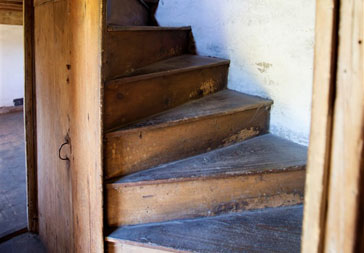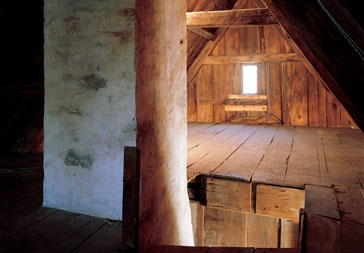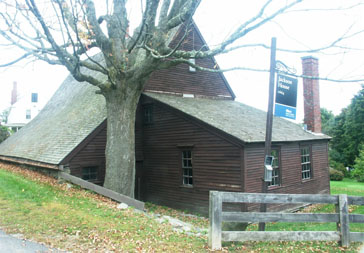 Richard Jackson Occupancy
Richard Jackson Occupancy
Jackson House, the oldest timber-framed dwelling in New Hampshire, was constructed with sawn lumber in the mid-seventeenth century. Richard Jackson, a cooper among other things, situated his house above the North Mill Pond which, when it was built, was “on the other side of Strawbery Banke Creek.” Richard owned twenty-five acres, which he merged with the adjoining twenty-five acres owned by his father-in-law. The house was built with vertical planks that run from the sill to the plate. There are no studs supporting the walls, only the window openings. The roof pairs rafters with the major posts, collar beams, and purlins to support vertical roof boards. The first-floor ceiling and second floors and ceiling are supported with impressive summer beams, complete with chamfered edges with lamb’s tongue stops.
Richard Jackson outlived his two sons, dying in 1718. In 1727 the house and land were divided between his daughter-in-law and her children. A tax bill from that same year shows that there were twelve “polls,” or men above the age of sixteen, living in the house. This number does not include women or children, which would bring the number of people living in Jackson House to a much higher number.
 Five Generations of Nathaniel Jackson Ownership
Five Generations of Nathaniel Jackson Ownership
Five generations of men named Nathaniel Jackson owned and occupied the house from 1727 to 1897. Nathaniel Jackson II was deeded half the house and his brother John, deemed to be “delirious above one year,” was deeded the other. Nathaniel Jackson III was also deeded only part of the house; his mother retained rights to one third of the house during her lifetime. Prior to 1769, during Nathaniel III’s occupancy, an addition was added to the east side of the house. By 1810, this addition was referred to as the “shop.” Another addition was added to the western side of the house in the very early nineteenth century.
Nathaniel IV inherited from both his father and his grandmother and finally Nathaniel V inherited the house in 1829, on his twenty-first birthday. Benjamin Jackson, brother of Nathaniel IV, was granted life rights to the western half of the house in 1824, but he sadly died just five years later.
 Mary Jackson Brown and the Tilley Family
Mary Jackson Brown and the Tilley Family
Nathaniel V’s daughter, Mary E. Jackson Brown, inherited the house in 1897 along with her son, another Nathaniel. The house was rented at this time to Clarence and Isabelle “Belle” Tilley, who were African-American. It is said that Belle came to New Hampshire via the Underground Railroad. Although Mary and Nathaniel sold the house to William Sumner Appleton and Historic New England in 1923, Belle retained life residency rights to the property until 1947.
 Becoming a Museum
Becoming a Museum
William Sumner Appleton, Historic New England’s founder, first visited Jackson House as a college freshman in 1893. In a letter dated April 4, 1923, he stated that “at the time I knew nothing about old houses but remember liking the place very much in a perfectly ignorant way.” He also visited the house in 1913, when Mary Jackson Brown was living there, but he did not gain access to the interior. He mentioned that the house seemed to be in good condition with fresh roof shingles and sills “not too badly out of plumb.” He also states that “altogether the house is one of the most interesting looking exteriors I know of.” It was so interesting to him that Appleton approached the Jackson family about purchasing the house in 1924.
Appleton’s thoughtful restoration of the Jackson House became the basis for Historic New England’s preservation philosophy of keeping generations of changes intact. In response to the urging of contemporaries to restore the house to its seventeenth-century appearance, he stated in a 1932 letter that “I would have to destroy much interesting old work…Even were this new wall built of old stock, it would still remain mine, and I much prefer the interesting alteration made by some long dead generation of Jacksons.”

 Richard Jackson Occupancy
Richard Jackson Occupancy Five Generations of Nathaniel Jackson Ownership
Five Generations of Nathaniel Jackson Ownership Mary Jackson Brown and the Tilley Family
Mary Jackson Brown and the Tilley Family Becoming a Museum
Becoming a Museum
